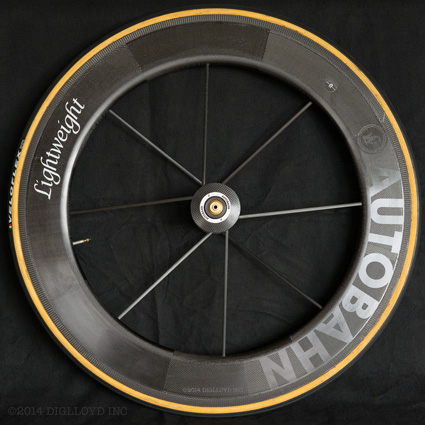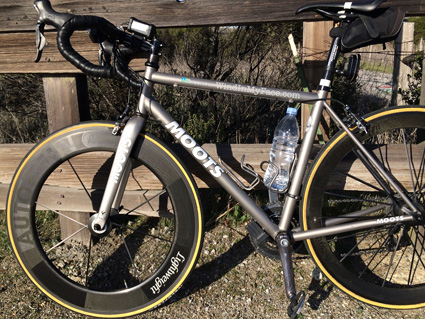Lightweight Autobahn VR Aerodynamic Performance

I’ve long been a skeptic of aerodynamic claims, for the simple reason that the bike and body present a huge frontal area, with the wheel presenting a far smaller cross section—how much could a wheel really save in that context?
Still, the frontal outer rim and tire have a velocity that is twice the bike speed, so the frontal drag concern is not one to be dismissed, since drag increases as the cube of the speed (so double speed is 8X more drag).
But one need only crouch down in the handlebar drops versus on top of the brakes hoods to note that at 30mph or so, it’s scarcely possible to read more than a few tenths speed differenceb by so doing. But what if no change in position (e.g., the wheel) still could yield a few tenths and maybe a bit more? That has big value over a longer course.
The aerodynamic performance of the Lightweight Autobahn deserves skepticism like any other wheel claimed to increase average speed (by reducing drag), but what is the factual reality out on the road?
My frame of reference is its predecessor, the 8-spoke Lightweight VR8, which has a notably lower cross sectional rim area, but the same number of spokes. As well as the Lightweight Obermayer 16 and 20-spoke wheels.
Speed gains?
With the same Veloflex Sprinter tubular tire used for both the VR8 and the Autobahn VR and same 8-spoke design for both wheels, the variables are well controlled: same tire drag, same tire pressure, same spoke count, same bike, same gearing, same rider, etc. Thus, the rim section depth (81mm vs 53mm) and spoke length were the only significant variance in comparing the two.
Remember that the VR8 is already an aerodynamic wheel. The Autobahn compared to other conventionally-spoked wheels (e.g. 20 spokes) should look even more favorable. As well, many conventional wheels have shallower rims than even the VR8, and thus less aerodynamic rim sections.
In the first rides with the Autobahn VR, the distinct impression of higher speed was noted immediately, but with variable wind conditions every day, quick assumptions would be an error.
Yet over 20 days of riding the same route (one also ridden for many years), some key findings emerged that leave little doubt about the superior aerodynamic characteristics of the Autobahn VR:
- Peak speed hits ~35 mph with the Autobahn VR vs ~34 mph for the VR8 on a frequently descended hill. It might be even a little better than that, e.g., 1.3 to 1.5 mph delta, but it is a consistent ~1 to ~1.5 mph difference.
- The frequency of “spinning out” (high cadence) occurs earlier and more frequently on descents. This is a direct mechanical/physical confirmation of higher speed that one can feel.
- A distinct impression of similar speeds at 5-10 watts lower power and/or higher speeds at similar power. This is hard to quantify due to continuously variable wind conditions, but the impression is consistent.
- A consistent feeling of “cheating”: catching up to other riders a little faster than years of experience would suggest. A few tenths of mph of speed steadily adds up over a half-mile gap.
- With wind interaction (stability) far better than anticipated, there is also the distinct impression of being veered and pulled forward at some wind angles, if only momentarily. It reminds me of an airfoil effect as on a cambered sail when windsurfing.
My impression is so favorable on all these counts that putting the Autobahn to use in at least some double centuries now seems like a very good idea, a way to prove out the wheel as a general purpose tool, not a specialty wheel. The Solvang Spring Double can have brutal wind for a ~30 mile section, but that tends to be into the wind, presumably an excellent situation to benefit from the Autobahn VR. As it turned out, the 2014 Solvang Spring Double had moderate winds, and the Autobahn VR performed brilliantly.
The Autobahn VR is definitely reducing the power drain (drag). That is a very exciting thing for endurance events, so the only question is whether real-world wind conditions can make it a risk in some venues (e.g., too-strong side-buffetting). But over 20 days of blustery early spring weather with wind at a variety of angles, not one day proved a problem.
And in spite of being nearly double the weight of the Lightweight Obermayer front wheel, it could actually be a wheel worth consideringfor the Everest Challenge, to save watts on those relatively flat areas as well as slightly higher speeds on moderate downhill slopes. But that is a tradeoff: the ~400 gram weight penalty over the Lightweight Obermayer is sure-loss when pedaling uphill. The tradeoff value is unclear without careful testing.
View HD, view Ultra HD.


(crappy iPhone 5s photo)


